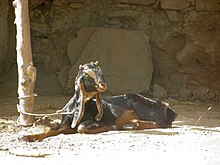Jamnapari
 | |
| Conservation status | |
|---|---|
| Other names |
|
| Country of origin | India |
| Distribution |
|
| Use | milk |
| Traits | |
| Weight |
|
| Height |
|
| |

Jamnapari, Jamunapari or Jumnapari is an Indian breed of domestic goat originating in Uttar Pradesh.[2][3] It has been exported to Indonesia, where it is known as the Etawah.[4]: 388 It is bred for both milk and meat.[citation needed] The name is derived from the Yamuna[5] river.
History[edit]
The Jamnapari originated in the Etawah District of Uttar Pradesh, and is particularly associated with the tehsil of Chakarnagar.[6] It is one of the ancestors of the Anglo-Nubian.[6]
In India there were an estimated 580,000 of the breed in the 1972 census, although less than 5000 were thought to be purebred.[5]
Characteristics[edit]
There is a large variation in color but the typical Jamnapari is white with patches of tan on the neck and head. Their heads tend to have a highly convex nose, which gives them a parrot-like appearance. They have long flat drooping ears which are around 25 cm (10 in) long. Both sexes have horns. The udder has round, conical teats and is well developed.[5] They also have unusually long legs.[7]
The Jamnapari male can weigh up to 40 kg (88 lb), while females can reach around 30 kg (66 lb) depending upon climates and environmental condition.
The average lactation yield per day has been found to be slightly less than two kilograms. Jamnapari meat is said to be low in cholesterol.[8]
During the winter they spend more than 90% of their time grazing, although this falls to around 55% in the hot Indian summer. The breed browses on bushes, tree leaves and the top of grasses rather than typical ground grazing.[6] Their mean heart rate was found to be 127 ± 3.46 in one study.[9]
Rates of conception are high, nearly 90%. Triplets and quadruplets are common. The average age of first conception is 18 months.[6]
See also[edit]
References[edit]
- ^ Barbara Rischkowsky, Dafydd Pilling (editors) (2007). List of breeds documented in the Global Databank for Animal Genetic Resources, annex to The State of the World's Animal Genetic Resources for Food and Agriculture. Rome: Commission on Genetic Resources for Food and Agriculture, Food and Agriculture Organization of the United Nations. ISBN 9789251057629. Archived 23 June 2020.
- ^ a b Breed data sheet: Jamunapari / India (Goat). Domestic Animal Diversity Information System of the Food and Agriculture Organization of the United Nations. Accessed March 2021.
- ^ R.M. Acharya (1982). Sheep and goat breeds of India. FAO Animal Production and Health Paper 30. Rome: Food and Agriculture Organization of the United Nations. Archived 1 February 2003.
- ^ Valerie Porter, Lawrence Alderson, Stephen J.G. Hall, D. Phillip Sponenberg (2016). Mason's World Encyclopedia of Livestock Breeds and Breeding (sixth edition). Wallingford: CABI. ISBN 9781780647944.
- ^ a b c "2.3 Goat Breeds".
- ^ a b c d P. K. Rout, A. Mandal, M. K. Singh, R. Roy, N. Sharma and G.F.W. Haenlein (2004). Jamunapari - A Dairy Goat Breed in India. Dairy Goat Journal. 82 (3): 37–39. Archived 11 October 2007.
- ^ Shelton, Maurice (1978). "Reproduction and Breeding of Goats".
- ^ Wariman, Noor H. "Jihad Ternak Planning To Export Jamnapari Goats". Archived 2016-03-03 at the Wayback Machine Accessed August 13, 2008.
- ^ N. H. Mohan1, D. Niyogi2, H. N. Singh3. "Analysis of normal electrocardiograms of Jamunapari goats". Archived 2011-07-28 at the Wayback Machine Journal of Veterinary Science.
